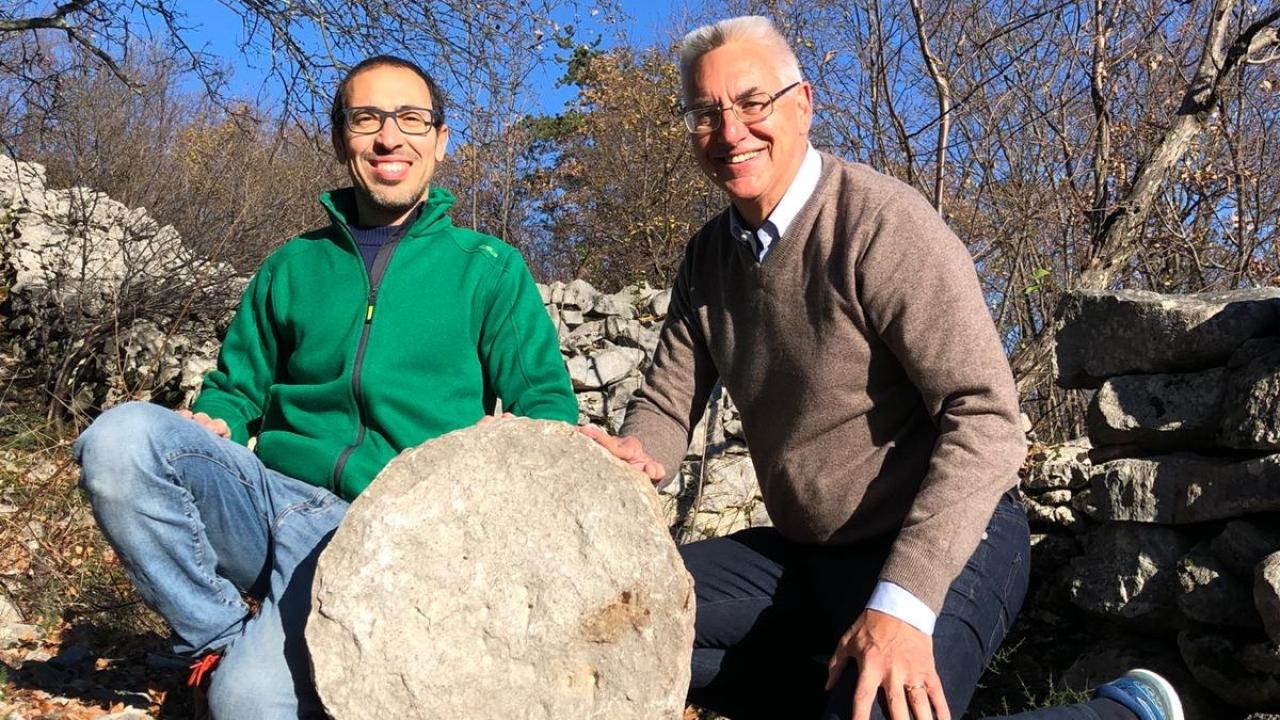
The Carso countryside around Trieste is full of hiking trails littered with ancient stone walls dating back to early settlements in the area. One trail near the village of Rupinpiccolo leads to the still-imposing entrance of a key ancient fortification; at this site, ICTP and INAF researcher Federico Bernardini recently discovered two unusually carved stones. These stones are circular, around 50 cm in diameter and 30 cm deep, with particular markings showing them to be astronomical charts. One of these could be the oldest star chart ever discovered.
Bernardini, long-term ICTP scientific collaborator and researcher at Ca’ Foscari University of Venice, has been working with Paolo Molaro, astronomer at the Italian National Institute for Astrophysics (INAF), to uncover the origin and significance of these stones. Federico talks to us about the find.
What exactly are the stones that were recently discovered in the Triestine Carso?
The two stones found in the Rupinpiccolo hillfort are circular artefacts that I identified near one of the entrances to the settlement. Castellieri are fortified settlements on elevated ground that emerged around 1800 BC and, in some cases, were used for almost two millennia. The stones had been worked to give them a circular shape. Traces of the stonework can be linked to stone extraction marks identified in areas adjacent to the settlement's fortification wall, most likely associated with the construction of the hillfort.
One of the stones has a flat surface, while the other displays engravings made with a chisel, forming distinct patterns. Similar stones have been discovered in a hillfort on the Island of Brioni, off the southern Istrian coast (Croatia). One of these stones also originates from an entrance to the settlement, while the other comes from a necropolis dating back to the 2nd millennium BC, adjacent to the settlement's fortification wall.
..the stone discs at Rupinpiccolo might have been ritual and sacred objects. The flat stone could represent the sun, while the one with engravings could represent the sky.
The entrances of settlements and necropolises were special places, and often, in the earliest phases of hillforts, the tombs of prominent figures were placed right at the entrances. These considerations, along with other clues, suggest that the stone discs at Rupinpiccolo might have been ritual and sacred objects. The flat stone could represent the sun, while the one with engravings could represent the sky.
The archaeo-astronomical study, conducted in collaboration with astronomer Paolo Molaro, has verified that the markings on the stone at Rupinpiccolo statistically align remarkably well with certain stars from the constellations of Scorpius, Orion, and the Pleiades. According to the proposed interpretation, the stone would represent a kind of calendar. Our study suggests that the stone could show the two asterisms that mark two turning points of the year (Scorpius, Orion). They could have been used to determine the times for agriculture tasks upon which the survival of an agricultural population like that of the castellieri depended.
How were you involved in the process of finding and analysing the stones?
I discovered the stones and studied them from an archaeological perspective to try to determine their chronology, likely contemporaneous with the hillforts. I had a hunch that some of the markings could correspond to the Scorpius constellation. To verify this possibility, I contacted Paolo Molaro, with whom we conducted the archaeo-astronomical study.
What techniques did you use in your part of the research?
Together with other colleagues, I used photogrammetry structure-from-motion techniques to produce accurate three-dimensional models of the stone discs. The 3D models were crucial for representing and studying the stones, defining the position of the chisel marks in space, and subsequently comparing them with the positions of the stars. Prior to this, we studied the ceramics from the hillfort to better define its chronology. I researched the technology involved in stone extraction and production, and identified one of the circular stones from the Brioni hillfort.
I mainly collaborated with Paolo for the archaeo-astronomical evaluation of the chiselmarks on the stones.
What does this find mean for the world?
The oldest known representation of the night sky is probably the Nebra Sky Disk, a bronze artefact from Germany with gold applications indicating the Sun, Moon, and the Pleiades. It dates back to around 1600 BC. However, it's not a true map; it's more of a symbolic representation. For accurate 'maps,' we have to wait until the first century BC, likely derived from Hipparchus' catalogue, dating back to 135 BC.
Accepting a protohistoric dating of the artefact, the relatively precise depiction of asterisms on the Rupinpiccolo stone would therefore be at least a few centuries earlier, representing the earliest known representation of the sky.
LINKS:
https://onlinelibrary.wiley.com/doi/full/10.1002/asna.20220108
https://journals.uni-lj.si/DocumentaPraehistorica/article/view/10741
















